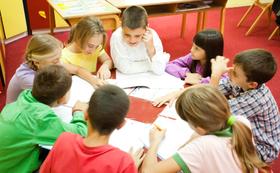Top Rankings
Argyle Independent School District ranks among the top 20% of public school district in Texas for:
Category
Attribute
Overall Rank
Highest overall rank (Top 5%)
Math Proficiency
Highest math proficiency (Top 5%)
Reading/Language Arts Proficiency
Highest reading/language arts proficiency (Top 5%)
Science Proficiency
Highest science proficiency (Top 1%)
Community Size
Largest student body (number of students) (Top 1%)
For the 2025-26 school year, there are 3 public preschools serving 2,613 students in Argyle Independent School District. This district's average pre testing ranking is 10/10, which is in the top 5% of public pre schools in Texas.
Public Preschools in Argyle Independent School District have an average math proficiency score of 72% (versus the Texas public pre school average of 47%), and reading proficiency score of 75% (versus the 53% statewide average).
Minority enrollment is 39% of the student body (majority Asian), which is less than the Texas public preschool average of 76% (majority Hispanic).
Overview
This School District
This State (TX)
# Schools
8 Schools
4,185 Schools
# Students
5,414 Students
2,148,412 Students
# Teachers
355 Teachers
147,701 Teachers
Student-Teacher Ratio
15:1
15:1
Student By Grade
District Rank
Argyle Independent School District, which is ranked #26 of all 1,196 school districts in Texas (based off of combined math and reading proficiency testing data) for the 2022-2023 school year.
The school district's graduation rate of 99% has increased from 95% over five school years.
Overall District Rank
#22 out of 1202 school districts
(Top 5%)
(Top 5%)
Math Test Scores (% Proficient)
73%
44%
Reading/Language Arts Test Scores (% Proficient)
77%
51%
Science Test Scores (% Proficient)
80%
46%
Graduation Rate
(21-22)≥99%
90%
Students by Ethnicity:
Diversity Score
0.56
0.63
% American Indian
1%
n/a
% Asian
14%
5%
% Hispanic
14%
55%
% Black
3%
13%
% White
63%
24%
% Hawaiian
n/a
n/a
% Two or more races
5%
3%
All Ethnic Groups
District Revenue and Spending
The revenue/student of $10,079 in this school district is less than the state median of $13,398. The school district revenue/student has declined by 29% over four school years.
The school district's spending/student of $16,885 is higher than the state median of $14,129. The school district spending/student has declined by 29% over four school years.
Total Revenue
$55 MM
$74,029 MM
Spending
$91 MM
$78,063 MM
Revenue / Student
$10,079
$13,398
Spending / Student
$16,885
$14,129
Best Argyle Independent School District Public Preschools (2025-26)
School
(Math and Reading Proficiency)
(Math and Reading Proficiency)
Location
Quick Facts
Rank: #11.
Argyle West
(Math: 71% | Reading: 79%)
Rank:
Rank:
10/
Top 10%10
1741 Old Justin Rd
Argyle, TX 76226
(940) 246-4007
Argyle, TX 76226
(940) 246-4007
Gr: PK-5 | 965 students Student-teacher ratio: 16:1 Minority enrollment: 37%
Rank: #22.
Hilltop Elementary School
(Math: 69% | Reading: 70%)
Rank:
Rank:
10/
Top 10%10
1050 Harrison Ln
Argyle, TX 76226
(940) 464-0564
Argyle, TX 76226
(940) 464-0564
Gr: PK-5 | 689 students Student-teacher ratio: 13:1 Minority enrollment: 22%
Rank: n/an/a
11800 Denton Creek Blvd
Argyle, TX 76226
(940) 464-7241
Argyle, TX 76226
(940) 464-7241
Gr: PK-5 | 959 students Student-teacher ratio: 16:1 Minority enrollment: 54%
Recent Articles

Public School Open House & Enrollment Season Guide
A parent-focused guide to the public school open house and enrollment season, with expert questions, timelines, and decision tips.

School Supply Budget 2026: Fees, Books, Tech Costs
School Supply Budget 2026 guide for parents, covering fees, textbooks, technology, and hidden extras to plan ahead.

Education Funding in America (2025 Update)
Comprehensive 2025 update on public school funding in America, new federal and state policies, per-pupil spending, and equity challenges.





